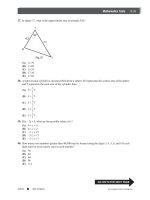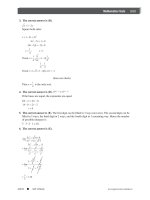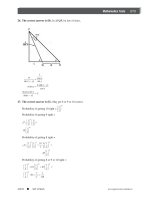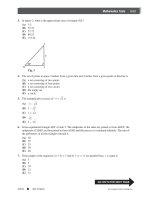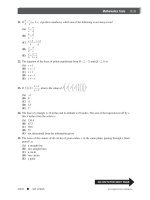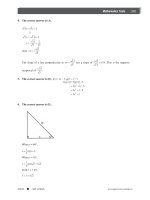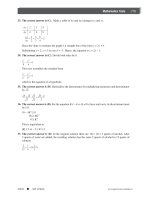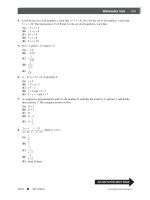SAT II Math Episode 1 Part 5 ppt
Bạn đang xem bản rút gọn của tài liệu. Xem và tải ngay bản đầy đủ của tài liệu tại đây (481.46 KB, 20 trang )
Math Review—Illustrative Problems and Solutions 75
ARCO ■ SAT II Math www.petersons.com/arco
13. Number Systems and Concepts
The Set of Integers
1. The set of natural numbers is made up of the ordinary counting numbers 1, 2, 3,…
2. The set of integers is made up of all positive and negative whole numbers and zero. An even
integer is any multiple of two; that is, it is any integer that can be written in the form 2n, where
n is any integer. Thus zero is considered an even integer (2 × 0). An odd integer is any integer
that is not even.
3. The sum of two odd integers or two even integers is an even integer. The sum of an odd integer
and an even integer is an odd integer.
4. The product of two odd integers is an odd integer. Any power of an odd integer is also an odd
integer. The product of any integer and an even integer is an even integer.
5. The set of integers is closed under addition, subtraction, or multiplication; that is, if any of these
operations is performed upon two integers, the result will also be an integer. The set of integers
is not closed under division, since the quotient of two integers is not always an integer.
The Set of Rational Numbers
1. A rational number is any number that can be written in the form , where p and q are integers
and q ≠ 0. The set of integers is a subset of the set of rational numbers since any integer p can be
written in the form of a ratio of p to 1.
2. The set of decimal fractions that can be written as finite decimals is also a subset of the set of
rational numbers, since a finite decimal can always be written as the ratio of an integer and a
power of 10. We can also show that infinite decimals that have repeating groups of digits can be
expressed as rational numbers.
3. An irrational number is any real number that is not rational. We can show that numbers like
and π are irrational numbers. Irrational numbers are infinite decimals whose digits do not
repeat endlessly in groups.
4. The set of rational numbers is closed under addition, subtraction, multiplication, and division,
except for division by zero, which is not defined.
5. The set of real numbers is made up of both the set of rational and the set of irrational numbers.
It is closed under the four basic operations, except for division by zero.
Properties of Real Numbers
1. The operations of addition and multiplication are commutative with respect to the set of real
numbers. Thus, if p and q are real numbers
p + q = q + p and p ⋅ q = q ⋅ p
2. The operations of addition and multiplication are associative with respect to the set of real
numbers. Thus, if p, q, and r are real numbers, then
p + (q + r) = (p + q) + r = p + q + r and p ⋅ (q ⋅ r) = (p ⋅ q) ⋅ r = pqr
Part III76
www.petersons.com/arco ARCO ■ SAT II Math
3. The multiplication of real numbers is distributive over addition. Thus, if p, q, and r are real
numbers,
p(q + r) = pq + pr
4. The number 0 is the identity element for addition of real numbers; that is, if p is a real number
p + 0 = p
5. The number 1 is the identity element for multiplication of real numbers; that is, if p is a real
number
p ⋅ 1 = p
6. The additive inverse of any real number p is –p.
p + (–p) = 0
7. The multiplicative inverse of any real number p, p ≠ 0, is
.
We also refer to as the reciprocal of p. The reciprocal of 1 is 1.
The Set of Complex Numbers
1. A complex number is any number that may be expressed in the form c + di where c and d are real
numbers and
. When c = 0, the number is called a pure imaginary number. When d = 0,
the number is a real number. The set of real numbers is a subset of the set of complex numbers.
2. In the complex number c + di, c is called the real part and d the imaginary part of the complex
number. Two complex numbers are equal if and only if their real parts are equal and their imagi-
nary parts are equal.
3. Sum of two complex numbers:
(a + bi) + (c + di) = (a + c) + (b + d)i
Product of two complex numbers:
(a + bi)(c + di) = (ac – bd) + (ad + bc)i
Thus,
4. The set of complex numbers is closed under addition, subtraction, multiplication, and division.
5. The number 0 is the additive identity element for the set of complex numbers. The number 1 is
the multiplicative identity element for the set of complex numbers (except for 0).
6. The commutative, associative, and distributive properties apply to the set of complex numbers
as they do for the set of real numbers.
Math Review—Illustrative Problems and Solutions 77
ARCO ■ SAT II Math www.petersons.com/arco
Illustrative Problems
1. Under which arithmetic operations is the set of even integers (including zero) closed?
Solution: Represent two even integers by 2x and 2y where x and y are integers.
2x + 2y = 2(x + y). Since (x + y) is an integer, 2(x + y) is an even integer.
2x– 2y = 2(x – y). Since (x – y) is an integer, 2(x– y) is an even integer.
(2x) ⋅ (2y) = 2(2xy). Since 2xy is an integer, 2(2xy) is an even integer.
But
need not be an integer.
The even integers (including zero) are closed under addition, subtraction, and
multiplication.
2. What complex number (in the form a + bi) is the multiplicative inverse of 1 + i?
Solution:
3. If
is an operation on positive real numbers, for which of the following definitions of
is
(commutative property)?
(A)
(B)
(C)
(D)
(E)
Solution: (D) (A) is not commutative because r – s ≠ s – r
(B) is not commutative because
(C) is not commutative because r
2
s ≠ s
2
r
(E) is not commutative because r
2
+ rs + s
4
≠ s
2
+ sr + r
4
(D) is commutative because
4. If a
2
– 2ab + b
2
= m, where a is an odd and b is an even integer, what kind of an integer is m?
Solution: (a – b)
2
= m, and so m is a perfect square, since a – b is an integer.
Also, the difference between an odd and an even integer is odd, and so (a – b) is odd and
(a – b)
2
is odd.
m is an odd perfect square.
Part III78
www.petersons.com/arco ARCO ■ SAT II Math
5. Consider the number 144
b
, which is written to the base b, b a positive integer. For what
values of b is the number a perfect square?
Solution:
The number is a perfect square for any integral value of b. However, since the digits up to
4 are used to write the number, b > 4.
6. Which of the following is an irrational number?
(A)
(B)
(C)
(D)
(E) none of these
Solution: (D) (A) is a rational fraction.
(B)
, which is rational .
(C)
, which is rational.
(D)
, which is irrational.
7.
Solution: Combine the fractions. L.C.D. = (2 – i)(2 + i)
22
22
44 144 1
41
8
5
22
+
()
−−
()
−
()
+
()
=
+ −− ++
−−
()
=
ii
ii
ii
i
8. What is the value of i
88
– i
22
?
Solution:
Math Review—Illustrative Problems and Solutions 79
ARCO ■ SAT II Math www.petersons.com/arco
9. If f(x) = x
3
+ x
2
+ 2x + 6, find f(i).
Solution:
14. Arithmetic and Geometric Progressions
A sequence of numbers such as 4, 7, 10, 13 … is called an arithmetic progression (A.P.). Note that each
term is obtained from the preceding term by adding 3; thus, the difference between any term and its
preceding term is 3. We call this number the common difference (d) of the progression or sequence. If the
successive terms decrease, we consider d to be negative.
If we designate the terms of an A.P. by a
1
, a
2
, a
3
… a
n
, we may easily develop the following formula
for the n
th
term, a
n
, in terms of a and d:
a
n
= a
1
+ (n – 1)d
The indicated sum of the terms of a progression is called a series. 4 + 7 + 10 + 13 + … may be
referred to as an arithmetic series or the sum of an arithmetic progression. The sum of the first n terms of
an A.P. is given by the formula
We may convert the S
n
formula to a more convenient form by substituting in it a
n
= a
1
+ (n – 1)d.
A sequence of terms such as 3, 6, 12, 24 … is called a geometric progression (G.P.). Here, the ratio
(r) of any term to its preceding term is constant, in this case, r = 2. If we designate the term of a G.P. by a
1
,
a
2
, a
3
, … a
n
, we can express a
n
in terms of a, and r as follows:
a
n
= a
1
r
n–1
The sum S
n
of n terms of a G.P. is given by the formula:
If the absolute value of the ratio, r, of a G.P. is less than 1, then the sum, S, of an infinite number of
terms has an upper limit and is given by the formula:
Illustrative Problems
1. Find the 15
th
term of the sequence 50, 46, 42, 38 …
Solution:
Part III80
www.petersons.com/arco ARCO ■ SAT II Math
2. Which term of the series 1, 6, 11 … is 96?
Solution:
3. Find the sum of the first 10 terms of the series 3 + 5 + 7 … + 21
Solution: a
1
= 3, n = 10, a
n
= 21
4. Find the sum of the first 20 terms of the series 15, , 12 …
Solution:
Math Review—Illustrative Problems and Solutions 81
ARCO ■ SAT II Math www.petersons.com/arco
5. Find the sum of all integers between 1 and 100 that are exactly divisible by 9.
Solution: The A.P. is 9, 18, 27 … 99.
6. Find the 9
th
term of the G.P.: 20, 10, 5,
…
Solution:
arn
aar
a
a
n
n
1
1
1
9
8
9
20
1
2
9
20
1
2
5
64
==
=
=
=
−
,, =
7. Find the sum of 5 terms of the G.P.: 27, 9, 3 …
Solution:
Part III82
www.petersons.com/arco ARCO ■ SAT II Math
8. Find the sum of the infinite G.P.: 12, 6, 3 …
Solution:
9. Write the repeating decimal .343434 … as a fraction.
Solution: Write the number as the sum of an infinite G.P.
15. Vectors
Forces and velocities are usually represented as vectors. A vector is a quantity having both magnitude and
direction.
We represent a vector by an arrow to show its direction, the length of which is proportional to the
magnitude of the vector.
If a vector a and a vector b react upon an object so that it moves in a new direction, this new vector
is called the resultant, or vector sum of a and b.
In some problems in mechanics we wish to reverse the above procedure; that is, given a vector, we
may want to find two perpendicular vectors that, when added, have the given vector as a resultant. These
two vectors are called components of the given vector.
Math Review—Illustrative Problems and Solutions 83
ARCO ■ SAT II Math www.petersons.com/arco
Illustrative Problems
1. A plane is flying north at 240 mph when it encounters a west wind blowing east at
70 mph. In what direction will the plane be going and with what speed?
Solution:
The scale drawing shows vectors for
velocities
and
. (The arrow is
used for a vector.) The vector
represents
the actual path of the plane. It is
obtained by completing the parallelogram
(or rectangle) PQSR. The length
of
represents the actual speed of
the plane.
The bearing angle is
tan .∠ ==−
∠≈°
RPS
m RPS
70
240
7
24
0 2917
16
The bearing is N 16° W.
Part III84
www.petersons.com/arco ARCO ■ SAT II Math
2. A force of 100 lb is acting at 30° to the horizontal. Find the horizontal and vertical
components of the given vector.
Solution:
The sca1e drawing shows the components
and
of the given vector
. From right triangle DEG,
Math Review—Illustrative Problems and Solutions 85
ARCO ■ SAT II Math www.petersons.com/arco
3. In some problems in mechanics, it may be necessary to find the difference of two vectors.
Given horizontal vector
and vertical vector
, find a vector equal to the difference
AB – AC. Both vectors have a magnitude of 10.
Solution:
Consider
–
as a vector equal to
in magnitude and opposite in direction. Thus
we are finding the resultant
of
and –
. From right
triangle AC’D, m∠ CAD = 45° and AD =
has a magnitude of 14
and bearing S 45° E.
16. Variation
Two algebraic functions are applied frequently in science problems. These are generally referred to as
variation problems.
The variable y is said to vary directly as the variable x if y = kx where k represents a constant value.
k is usually called the constant of variation or proportionality constant.
Part III86
www.petersons.com/arco ARCO ■ SAT II Math
The graph of this relationship is a straight line passing through the origin. k is equal to the slope of
the line, where the slope refers to the ratio of the change in y to the change in x.
If the volume of an ideal gas is kept constant, the pressure varies directly with the temperature; P =
kT. If one pair of values is given for T and P, k can be determined. In many scientific formulas of this type,
the units are frequently defined so that k = 1.
The variable y is said to vary inversely as x if
where k is a constant. For example, for several
automobiles traveling the same distance, the time t in hours varies inversely as the rate r in miles per hour.
In this case the constant of variation is the distance in miles, since
.
The variation may also be written xy = k. The graph of this relation is an equilateral hyperbola
as shown in the figure. The specific hyperbola will depend on the value of k.
Direct and inverse variations may take several different forms. These are best illustrated in the
problems below. If z varies directly as x and y, then z = kxy, where k is a constant. This is sometimes called
joint variation.
If z varies directly as x and inversely as y, then
, where k is a constant.
Math Review—Illustrative Problems and Solutions 87
ARCO ■ SAT II Math www.petersons.com/arco
Illustrative Problems
1. An auto traveling at a rate of 40 mph covers a distance in 3 hours. At what rate must the
auto travel to cover the same distance in 2 hours?
Solution: The greater the rate the car travels, the less the time it takes to cover the same distance.
Thus, the rate varies inversely with time
, where k is the constant of proportionality
(distance). Substitute r = 40 when t = 3. k = 120.
2. If y varies inversely as the square of x, then if x is
(A) multiplied by 2, y is multiplied by 2
(B) increased by 2, y is increased by 4
(C) divided by 2, y is multiplied by 4
(D) decreased by 2, y is increased by 2
(E) multiplied by 2, y is decreased by 2
Solution: (C)
Replace x by and let the new value of y be y' .
When x is divided by 2, y is multiplied by 4. Likewise, replace x by 2x
. (A) is not true.
Replace x by x + 2.
. (B) is not true.
Similarly, (D) and (E) can be shown to be untrue.
The only correct choice is (C).
Part III88
www.petersons.com/arco ARCO ■ SAT II Math
3. The surface area of a sphere varies directly as the square of a radius. If the area is 36π sq
cm when the radius is 3 cm, what is the area when the radius is 5 cm?
Solution:
4. If s varies directly as t
2
,
what is the constant?
(A) the product of s and t
2
(B) the square of s and t
(C) the quotient of s and t
2
(D) the sum of s and t
2
(E) the difference of s and t
2
Solution: (C)
Part
IV
89
ARCO ■ SAT II Math www.petersons.com/arco
MATH PRACTICE EXERCISES AND SOLUTIONS BY TOPIC
1. Formulas and Linear Equations
1. If 6x –18 = 5, what does x – 3 equal?
2. The formula
converts Fahrenheit readings (F) into Centigrade readings (C). For
which temperature are the readings the same?
3. If V = Bh and B = πr
2
, find V in terms of r and h.
4. If t(z – 3) = k, what does z equal?
5. Solve for d: 3c – d = 30 and 5c – 3d = 10
6. If 7r – 8 = 6 + 7s, what does r–s equal?
7. If 5p – q = 9 and 10p – 2q = 7, then
(A) p = q
(B) p > q
(C) p < q
(D) p = q ≠ 0
(E) cannot be determined from the information given
8. Using the formula , find b in terms of A, h, and c.
9. Solve for x and y:
(Solutions on page 105)
2. Algebraic Fractions
1. Combine:
2. Find the capacity of an oil tank if an addition of 15 gal raises the reading from to full.
3. Write the sum of
and as a single fraction in simplest form.
4. Find the product:
Part IV90
www.petersons.com/arco ARCO ■ SAT II Math
5. Write the complex fraction as a simple fraction.
6. Express in simplest form:
7. Solve for y:
8. Express as a fraction in simplest terms:
9. Express as a single fraction in simplest terms:
(Solutions on page 108)
3. Sets
1. A is the set of odd numbers between 0 and 6.
B is the set of whole numbers greater than 1 and less than 6.
List the members of the set that is the intersection of sets A and B.
2. The solution set of
is
(A) {1}
(B) { }
(C) {3}
(D) {3, –3}
(E) {–3}
3. Given: set A = {a,b,c,d} with a defined operation whose symbol is *. Which statement expresses
the fact that b is the identity element for this operation?
(A) a * a = b
(B) a * b = a
(C) a * b = b
(D) a * b = c
(E) b * c = a
4. If P and Q are disjoint sets, then
(A) P ⊂ Q
(B) P ∩ Q = U
(C) P ∩ Q = { }
(D) P ∪ Q = { }
(E) Q ⊂ P
Math Practice Exercises and Solutions by Topic 91
ARCO ■ SAT II Math www.petersons.com/arco
5. In a school of 1300 students, all students must study either French or Spanish or both. If 800
study French and 700 study Spanish, how many students study both?
6. Let S = {a,b,c}. How many subsets does it have including itself and the empty set?
7. If A = {1,2,3,4,5,6} and B = {2,4,6,8,10}, how many elements are in A ∪ B?
(Solutions on page 110)
4. Functions
1. Which relation is a function?
(A) {(x,y)|x
2
+ y = 4}
(B) {(x,y)|x
2
+ y
2
= 4}
(C) {(x,y)|x
2
– y
2
= 4}
(D) {(x,y)|x
2
+ 4y
2
= 4}
(E) {(x,y)|x
2
– 4y
2
= 4}
2. If f(x) = x
2
– 2x + 4, what is f(i) where ?
3. The function f(x) = x – x
2
has its maximum value when x equals
(A) 1
(B) –1
(C)
(D) 0
(E)
4. Express the sum of 3 consecutive even integers as a function of n where n is the least integer.
5. If f(x) = 2x – 3 and g(x) = x + 1, then what does f(g(x)) equal?
6. Write the inverse of the function f as defined by f(x) = 2x – 3.
7. Find the largest real range of the function
.
8. The function f is defined as
where x ≠ 3. Find the value of k so that the inverse of
f is
9. If the functions f and g are defined as f(x) = x
2
– 2 and g(x) = 2x + 1, what is the function f[g(x)]?
(Solutions on page 111)
Part IV92
www.petersons.com/arco ARCO ■ SAT II Math
5. Exponents
1. Solve for x: 3
x+1
– 5 = 22
2. If the number 0.0000753 is written in the form 7.53 × 10
n
, what is the value of n?
3. Find the solution set of 4
x–1
= 2
x
.
4. When x = 27, what is the value of (x
–2
)
1/3
?
5. If 5
p
= 192, between what two consecutive integers does p lie?
6. The wavelength of violet light is .000016 in. Write this number in scientific notation.
7. Write the numerical value of r
2/3
– (4r)
0
+ 16r
–2
when r = 8.
8. Solve for n: 27
6–n
= 9
n–1
9. Solve for
(Solutions on page 113)
6. Logarithms
1. If log x = 1.5877 and log y = 2.8476, what is the numerical value of log ?
2. The expression log
b
x = 1 + c is equivalent to
(A) b
1+c
= x
(B) x
1+c
= b
(C) b + bc = x
(D) x = (1 + c)
b
(E) b
1–x
= c
3. The expression log 2xy is equivalent to
(A) 2(log x + log y)
(B) 2(log x)(log y)
(C) 2log x + log y
(D) log2 + log x + log y
(E) log x + 2log y
Math Practice Exercises and Solutions by Topic 93
ARCO ■ SAT II Math www.petersons.com/arco
4. The diagram below represents the graph of which equation?
(A) y = 2
x
(B) y = 10
2
(C) y = log
2
x
(D) y = log
10
x
(E) y = 10 logx
5. log
3
92 is between what pair of consecutive integers?
6. If P = K 10
-xt
, x equals
(A)
(B)
(C)
(D)
(E)
7. If log
r
6 = S and log
r
3 = T,
is equal to
(A)
(B) 1 – S + T
(C) 1 – S – T
(D) log
r
2 – 1
(E) 1 + S + T
(Solutions on page 114)
Part IV94
www.petersons.com/arco ARCO ■ SAT II Math
7. EquationsQuadratic and Radical
1. For what value of c are the roots of the equation x
2
+ 6x + c = 0 equal?
2. What is the solution set of
?
3. Find the roots of 2x
2
– 7x + 3 = 0.
4. If –1 satisfies the equation x
2
–3x – k = 0, what is the value of k?
5. What is the solution set of
?
6. What is the total number of points whose coordinates satisfy the equations of both x
2
+ y
2
= 4
and y = 4?
7. Solve the system of equations: 3r
2
– rs = 3 and 6r –s = 10
8. Solve the equation
for t in terms of s.
9. Find, in radical form, the roots of x
2
– 6x + 7 = 0.
10. The sum of two numbers is 12 and the sum of their squares is 80. Find the numbers.
(Solutions on page 115)
8. Inequalities
1. If 2x + 2 > 8, what is the solution set of the inequality?
2. Solve for t: t – 2 < 3(t – 5)
3. In the figure, if 90 < q < 180, what is the range of values x may assume?
4. (x + y)
2
< x
2
+ y
2
if
(A) x
2
< y
2
(B) x < y
(C) y < x
(D) xy < 0
(E) x = y
5. Find all values of p that satisfy the inequality –3p + 2 > 11.

